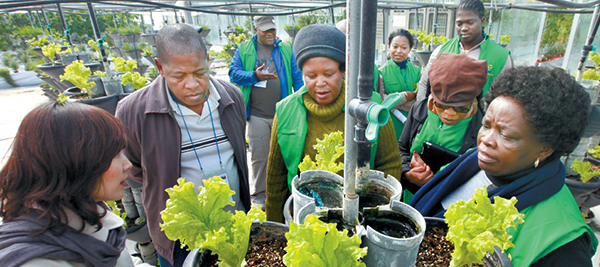South Africans gain insight into Saemaeul success

A group of South African government officials learn the secret of automatic irrigation systems during their visit to the Yeoju Institute of Farm Management on Oct. 31. The 11 officials from the southernmost African nation participated in an 18-day training program on the Saemaeul Movement to receive on-the-ground insight into Korea’s success in urbanization. By Park Sang-moon
YEOJU COUNTY, Gyeonggi - “To us, the Saemaeul Movement was like a revolution promoted by the state that made the lives of so many people much better in a remarkably short period of time,” said Sibusiso W. Mdabe, mayor of South Africa’s iLembe District Municipality. The mayor visited the Yeoju Institute of Farm Management on Oct. 31 with 10 of his fellow government officials from South Africa.
“The Saemaeul reforms transformed barren countryside into land equipped with perfect irrigation and sewage systems and we came here to do exactly the same back in South Africa.”
Mdabe was one of 11 South African central and local government officials who came to Korea for the purpose of learning the fundamental principles of the New Village Movement, or the Saemaeul Movement, during their 18-day training program, from Oct. 18 until Nov. 3, organized by the Saemaul Undong Central Training Institute.
The training program for the 11 officials aimed to provide them with on-the-ground insight into the success of the urbanization project initiated in 1971 by the Park Chung Hee regime. The project focused on creating infrastructure in rural areas to aid in agriculture production and modernizing the living conditions of people in the countryside.
Most notably, the institute emphasizes helping them grasp “the idea of team spirit,” according to Lee Dong-hyo, director of the global Saemaeul education division at the state-run institute.
“We are trying to inject this sense of community and fellowship to the African officials that they are one group that should unite behind a common goal that would result in everyone’s benefits,” he said.
“Based on my encounters with many African officials visiting here to learn the secrets of Korea’s success in the new village project, this notion of group-oriented thinking is something unfamiliar to many from African nations, including government officials.”
Lee said as a way to motivate officials to work as a group and instill team spirit, the institute holds group exercise early in the morning and encourages group discussions to produce viable solutions to potential social and economic obstacles.
“During the trip, I was most surprised to learn about the government-led Saemangeum land reclamation project,” said Cecil Malti, a female deputy director of the South African Local Government Association. “The idea of creating land the size of a medium-sized city by filling the estuary is just remarkable.”
During their visit to the Yeoju farm management institute in Gyeonggi, which was established in 1945 to nurture advanced farming skills and educate professionals in the agriculture field, the officials were most impressed by the automatic irrigation systems installed inside the greenhouse that enables water to be used again for plants through recycling.
“As many farming regions in South Africa are deprived of abundant water sources, the irrigation system that recycles water would greatly improve agricultural conditions for South African farmers,” said Mdabe.
“A lot of farmland in South Africa now resembles many aspects of the Korean countryside in the 1960 before the Saemaeul reforms started,” said Ramadimetia Shirley, deputy director of Pretoria’s department of rural development in one of South African capital cities.
“We came here to learn the role of the central government in the movement, whose leading role was crucial in ensuring a success in the urbanization project.”
The South Africans on their visit to the farm management institute also took interest in vegetative propagation, in which a plant can reproduce from cuttings of its own stems, not from seeds, asking how much commercial value those plants can have in the market.
“All we have to do to make more of these plants is to make a cutting,” lectured Professor Hong Yun-jeong.
“After we plant the cutting in a pot, the root and leaves will grow from the cutting, thus we could save in costs related to replanting.”
“How long does it take to grow plants this way?” and “Would they grow well in the weather of South Africa?” were two of many questions raised by the official.
Mdabe told the Korea JoongAng Daily at the Yeoju farm management institute that the underlying concept of the Saemaeul project is “both interesting and inspiring” not only to him but to “many government officials in developing countries.”
“Once the training is done here, I will try to have many officials in South Africa understand the concept of this platform ‘let’s live well all together.’?”
“We will also make sure to urge those in public office to look at how Korean people worked together for prosperity that benefitted everyone.”
By Kang Jin-kyu [jkkang2@joongang.co.kr]










with the Korea JoongAng Daily
To write comments, please log in to one of the accounts.
Standards Board Policy (0/250자)